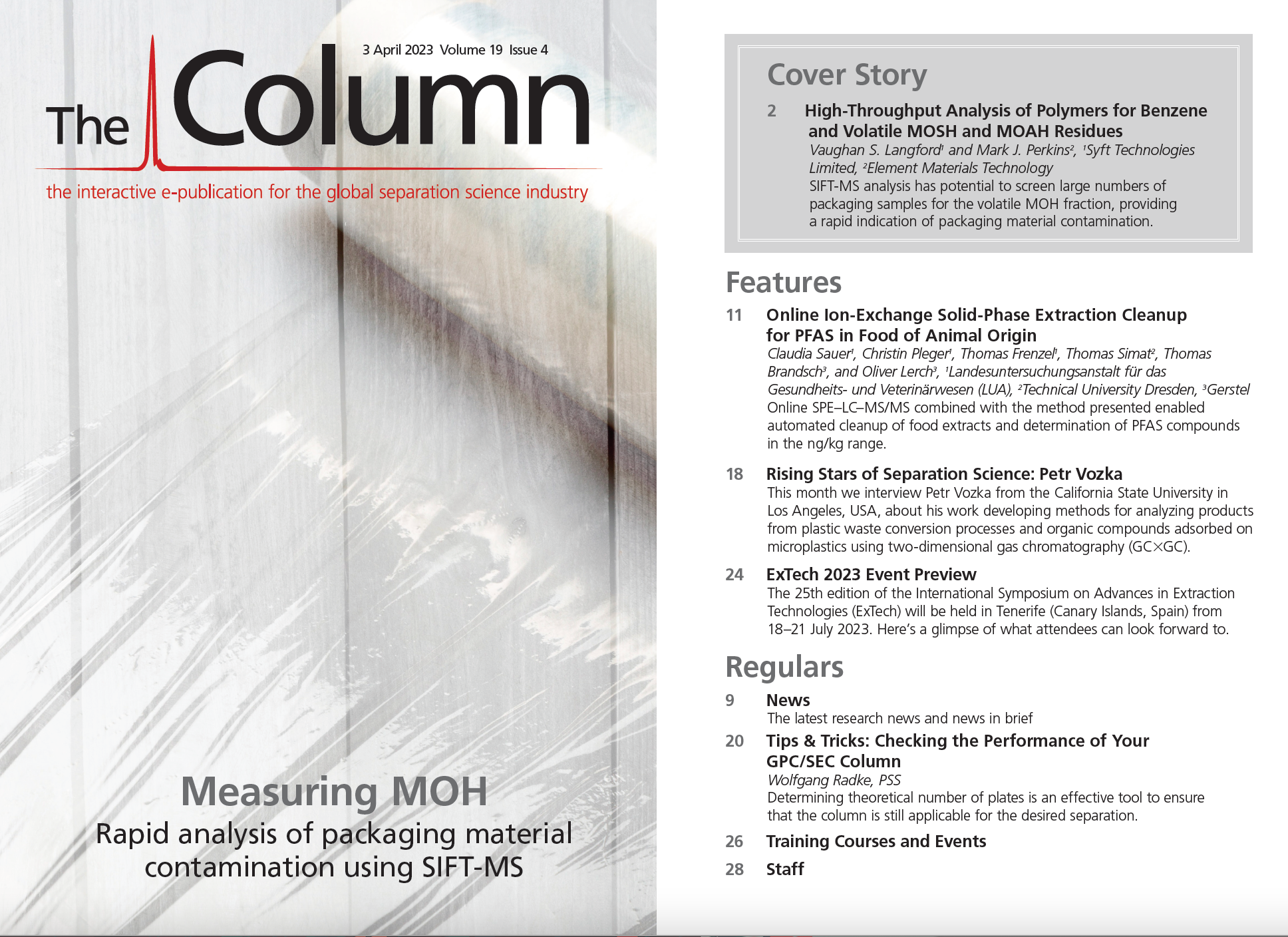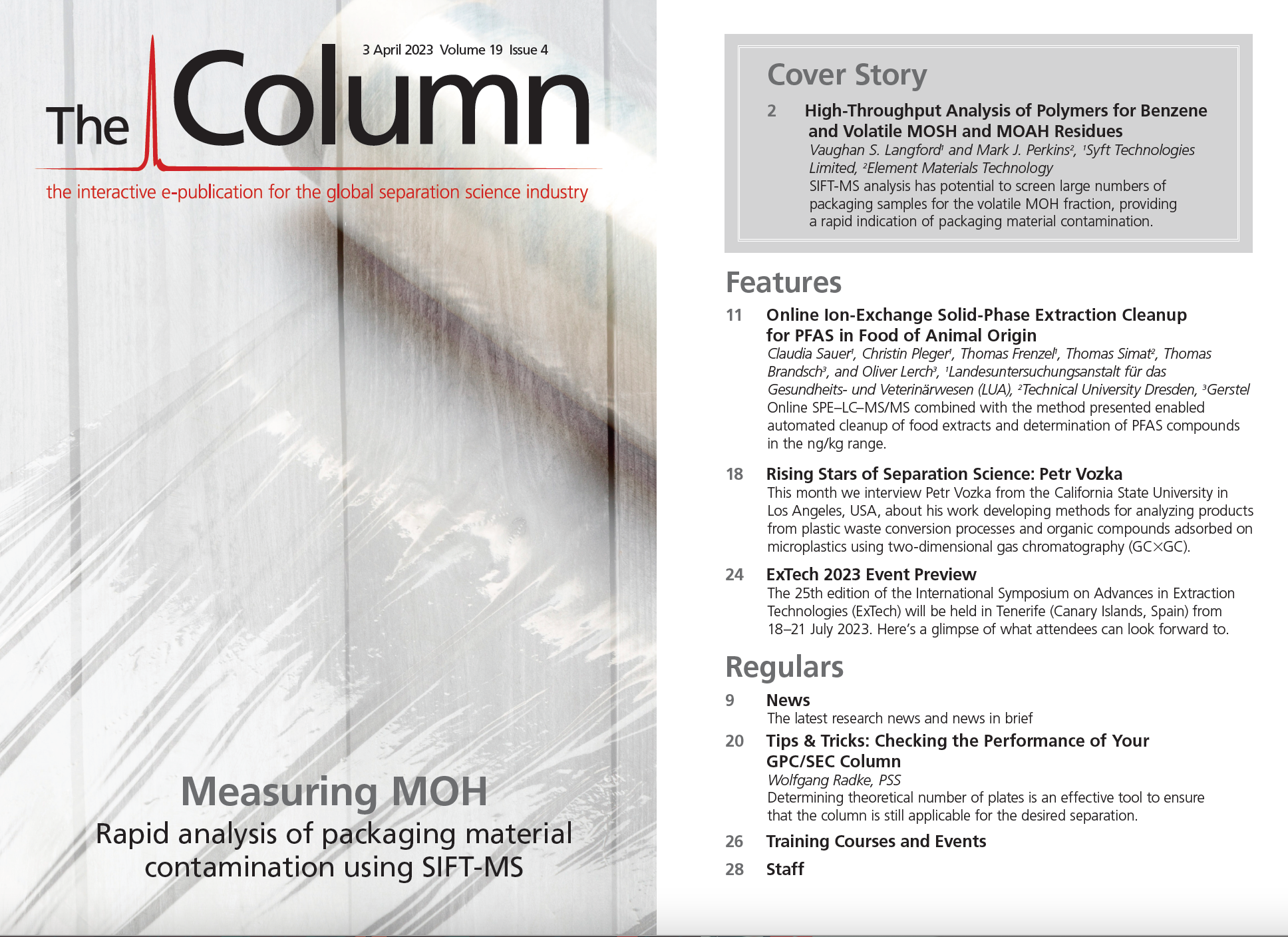High-Throughput Analysis of Polymers for Benzene and Volatile MOSH and MOAH Residues
Mineral oil hydrocarbons (MOH) are widely used as lubricants and may contain carcinogenic and mutagenic impurities. Hence, food safety authorities require that ingredients, finished products, and packaging materials be tested. Comprehensive analysis of MOH utilizes a combined liquid (LC) and gas chromatography (GC) procedure, which is challenging and time-consuming. This article demonstrates that automated headspace-selected ion flow tube mass spectrometry (SIFT–MS) analysis has potential to screen large numbers of packaging samples—over 220 per day—for the volatile MOH fraction, providing a rapid indication of packaging material contamination. Moreover, SIFT–MS can simultaneously quantify benzene contamination—addressing this recently identified need for personal care products (PCPs).
Polymers are synthesized by polymerization of low-molecular-weight organic compounds, and therefore monomer residues and other volatile by-products can be trapped in the polymeric material. Recycled polymers may contain additional volatile impurities that have migrated into the material during prior use and/or that were generated through the recycling process. Determination of the identities and levels of volatile impurities is important for manufacturers planning to use recycled polymeric materials in packaging materials—whether of pharmaceutical products, foods, or personal care products (PCPs)—since they can migrate through the polymer into the product.
For food contact materials (FCMs), the so-called “MOSH and MOAH” analysis (mineral oil saturated hydrocarbons and mineral oil aromatic hydrocarbons, respectively) for mineral oil hydrocarbon (MOH) content is widely utilized because packaging is suspected of being a major source of these impurities (1). MOH is an extremely complex mixture of hydrocarbons and tends to elute from standard chromatographic analyses as a broad band, rather than as individually resolved components (1,2), so the test reports total MOSH and total MOAH content for hydrocarbons in the C10–C50 range. Highly sophisticated, automated sample preparation and analysis solutions comprising both liquid (LC) and gas chromatography (GC) steps have been developed with a throughput of up to two samples per hour (Figure 1). This article explores the potential application of selected ion flow tube mass spectrometry (SIFT–MS), a direct-injection MS technique, for pre-screening polymer packaging materials for volatile MOSH and MOAH based on the demonstrated ability of SIFT–MS to analyze headspace samples at a throughput of 12 samples per hour (3) (Figure 1). Furthermore, headspace-SIFT–MS analyzes benzene at high sensitivity as part of the same analysis, addressing one facet of the emerging need to reduce benzene content in PCPs (4). In this study, high-density polyethylene (HDPE) and polypropylene (PP) systems are evaluated as representative polymeric systems.

Experimental
Analytical Methodology
The SIFT–MS technique is described in detail elsewhere (5). Briefly, rapidly switchable reagent ions (H3O+, NO+, and O2+) were utilized for gas-phase soft chemical ionization of trace volatile organic compounds (VOCs) in air and headspace. Real-time, high-throughput analysis was achieved because SIFT–MS is chromatography-free. Selectivity was achieved through the combination of multiple ionization mechanisms and mass spectrometric detection. A SIFT–MS instrument was used in this work (Voice200ultra, Syft Technologies).
Automated headspace-SIFT–MS analysis (3) was achieved using a multipurpose autosampler (MPS Robotic Pro, Gerstel). Headspace was sampled using a 2.5-mL headspace syringe (heated to 150 °C) and subsequently injected at a flow rate of 50 μL/s into the SIFT–MS instrument’s autosampler inlet (heated to 150 °C) via a self-sealing septumless sampling head (Gerstel). Since the nominal sample flow into the SIFT–MS instrument is 420 µL/s, a make-up gas flow (ultra-high purity nitrogen) was also introduced through the sampling head.
In this study, full-scan data were collected for each sample in a single analysis within 40 s using all three positively charged reagent ions. For both MOSH and MOAH components, headspace concentrations for compounds with carbon numbers up to C16 were calculated from these data using a method described recently (6). Briefly, the benzene alkyl derivatives were targeted as representative of the MOAH class. The naming convention employed here for aromatic species refers to the number of carbons in the side chains. For example, the total concentration measured for the sum of ethylbenzene and the xylene isomers is referred to as “C2-alkylbenzenes”. The MOSH class was targeted via alkanes containing 10 to 16 carbon atoms (C10–C16). Each measurement represents a total of the alkanes of a given carbon number (for example, “C10-alkanes” includes n-decane and all its branched isomers).
Samples
Tables 1 and 2 summarize the HDPE and PP samples, respectively, that were used in this study. A variety of virgin and recycled products were analyzed (1 g in 20-mL sample vial; 10 replicates per sample) in randomized order and with interspersed blanks (every 10 samples) for the two data collection events (one for each polymer type). Samples were incubated at 80 °C for 20 min.


Results and Discussion
Figure 2 summarizes the results obtained from reprocessing SIFT–MS full-scan data obtained for the 14 HDPE and seven PP samples. The MOSH and MOAH components lie within the original acquisition range (up to 250 m/z). For each type of polymer, the contributions for benzene and the other sub-MOAH aromatics are shown separately. For the alkanes, the C2n and C3n contributions for HDPE and PP, respectively, are summed separately (purple in Figure 2) from the other carbon chain lengths (pink) to distinguish between the alkane contributions arising from monomer building blocks (ethylene and propylene) and alkanes from other sources. Volatile MOSH and MOAH concentrations were easily determined using SIFT–MS. Although the recycled HDPE samples generally had the largest MOSH and MOAH concentrations, a PP sample (P-R4) was the worst overall (it corresponded to “worst-case” post-consumer recyclate, whereas P-R3 was “best-case”). For HDPE and PP, respectively, Tables 1 and 2 rank the total volatile MOSH and MOAH emissions. Compared to total volatile emissions, these rankings differ due to the presence of non-MOSH/MOAH volatile residues. Volatile MOSH and MOAH emissions from virgin polymer samples were dominated by the C2n alkanes for HDPE (Figure 2[a]) but show quite different abundances—with the highest emissions from the scientific product (sample H-V4). In contrast, recycled HDPE samples had quite different MOSH/MOAH profiles. First, there was a significant non-C2n presence, which—based on the limited sample set studied here (Table 1)—suggests that these arise from degradation in the cleaning and extrusion process and/or residual contamination from prior use. Aromatic hydrocarbons also appear at significant levels in recycled HDPE. Unless these residues arise from degradation of additives during recycling, their origin appears to be from prior use. The aromatics were present over a broad range of carbon numbers, since the common solvents (C2- to C3-alkylbenzenes in mineral turpentine) and higher aromatics (C4- to C10-alkylbenzenes; low molecular mass MOAH) both occurred at significant concentrations.

For PP (Figure 2[b]), the distinction between virgin and recycled products was less clear—at least for this limited sample set. In addition to C3n alkane residues, both virgin and recycled PP had significant concentrations of alkanes that were not multiples of the monomer unit (C10, C11). This appears to be as a result of polymer synthesis, so the alkanes do not assist authentication of virgin product. Volatile MOAH residues (C4- to C10-alkylbenzenes) occurred in all recycled products and in one virgin product (craft; P-V2). Hence the volatile MOAH analysis may be useful for authenticating high-grade virgin PP versus low-grade virgin and recycled products. Due to benzene’s deleterious health effects, there have been recent concerns about its detection in numerous PCPs (4). In these polymer samples, although benzene content is visible in Figure 2 only for samples H-R5 and H-R7, benzene was present at trace levels in many samples (Figure 3). Only virgin HDPE and one recycled HDPE (H-R6) were essentially free of benzene. The levels in several recycled HDPE samples were high, whereas although all PP samples have benzene residue, concentrations were at the lower end of the recycled HDPE samples. The results obtained for the recycled HDPE samples were of concern since these samples were being evaluated for use in consumer product packaging. It is clear from these data that recycled HDPE, in particular, and recycled PP should be screened for benzene content prior to reuse.

Conclusion
The increased use of recycled plastic in consumer packaging means that increased testing of volatile residues is required. This study has demonstrated that SIFT–MS can rapidly screen polymeric materials for volatile MOSH and MOAH residues. For HDPE, in particular, an increase in MOAH was observed after polymer use and recycling compared to virgin HDPE. With a throughput of over 220 samples per day (not including standards and blanks), automated SIFT–MS analysis has the potential to pre-screen samples for volatile MOSH and MOAH prior to more expensive LC or GC analysis.
Furthermore, SIFT–MS analysis can quantify benzene impurities at high sensitivity, protecting PCPs, as well as pharmaceuticals and food products, from contamination. This study has demonstrated that benzene contamination is a significant risk factor in the use of recycled HDPE and should be addressed through increased testing. Automated SIFT–MS analysis has the potential to provide enhanced quality control through faster analysis and simplified workflows, while supporting sustainability initiatives.
References
(1) EFSA Panel on Contaminants in the Food Chain (CONTAM). Scientific Opinion on Mineral Oil Hydrocarbons in Food. EFSA Journal 2012, 10, 2704. DOI:10.2903/j.efsa.2012.2704
(2) Guidance on Sampling, Analysis and Data Reporting for the Monitoring of Mineral Oil Hydrocarbons in Food and Food Contact Materials; Bratinova, S.; Hoekstra E., Eds.; Publications Office of the European Union, 2019. DOI:10.2760/208879
(3) Perkins, M. J.; Langford, V. S. Application of Routine Analysis Procedures to a Direct Mass Spectrometry Technique: Selected Ion Flow Tube Mass Spectrometry (SIFT-MS). Rev. Sep. Sci. 2021, 3 (2), e21003. DOI:10.17145/rss.21.003
(4) Bettenhausen, C. A. Finding Benzene Everywhere We Look. Chem. & Eng. News 2022, 100 (1), 24–26.
(5) Smith, D.; Španěl, P.; Demarais, N.; Langford, V. S.; McEwan, M. J. Recent Developments and Applications of Selected Ion Flow Tube Mass Spectrometry (SIFT-MS). Mass Spec. Rev. 2023, e21835. DOI:10.1002/mas.21835
(6) Perkins, M. J.; Langford, V. S. Simple, Rapid Analysis of Packaging for Volatile MOSH and MOAH Contaminants. Syft Technologies Application Note 2022. http://bit.ly/3iEIGD1 (accessed 2023-01-16).
About the Authors
Vaughan Langford is a principal scientist at Syft Technologies in New Zealand. He joined Syft in late 2002 after completing his Ph.D. in physical chemistry at the University of Canterbury, and postdoctoral fellowships at the Universities of Geneva, Western Australia, and Canterbury. He has over 30 peer-reviewed publications on a wide range of SIFT-MS applications, and has contributed numerous conference papers.
Mark Perkins is a senior applications chemist and SIFT-MS expert at Element Materials Technology (formerly Anatune), based in Cambridge, United Kingdom. Mark graduated from the University of Southampton, UK, with a Ph.D. in electrochemistry. He was with the Malaysian Rubber Board’s UK research centre for 12 years, first as a senior analyst, then as head of the analytical section. He joined Element in early 2015 in a role that supports and expands the analytical capability of SIFT-MS—with a particular focus on autosampler integration and the development of automated test methods.
Email: vaughan.langford@syft.com / mark.perkins@element.com
Website: www.syft.com

Analytical Challenges in Measuring Migration from Food Contact Materials
November 2nd 2015Food contact materials contain low molecular weight additives and processing aids which can migrate into foods leading to trace levels of contamination. Food safety is ensured through regulations, comprising compositional controls and migration limits, which present a significant analytical challenge to the food industry to ensure compliance and demonstrate due diligence. Of the various analytical approaches, LC-MS/MS has proved to be an essential tool in monitoring migration of target compounds into foods, and more sophisticated approaches such as LC-high resolution MS (Orbitrap) are being increasingly used for untargeted analysis to monitor non-intentionally added substances. This podcast will provide an overview to this area, illustrated with various applications showing current approaches being employed.
New Method Explored for the Detection of CECs in Crops Irrigated with Contaminated Water
April 30th 2025This new study presents a validated QuEChERS–LC-MS/MS method for detecting eight persistent, mobile, and toxic substances in escarole, tomatoes, and tomato leaves irrigated with contaminated water.

.png&w=3840&q=75)

.png&w=3840&q=75)



.png&w=3840&q=75)



.png&w=3840&q=75)










